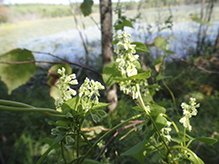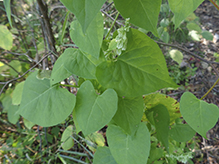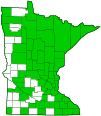climbing false buckwheat
(Fallopia scandens)
Conservation • Wetland • Description • Habitat • Ecology • Use • Distribution • Taxonomy
Description |
||
Climbing false buckwheat is a native, weedy, herbaceous vine. It occurs in the United States from the East Coast to the Great Plains, in adjacent Canadian provinces, and in Mexico. It is common in Minnesota. It is found in thickets and open floodplain forests, at the edges of forests and woodlands, on river banks and fence rows, and in ditches and disturbed sites. It grows under partial sun in moist to moderately moist conditions in fertile, loamy soil. It usually climbs over adjacent vegetation, and can smother small shrubs. In open areas it sprawls on the ground and forms mats. Climbing false buckwheat is a perennial vine that rises from fibrous roots and sometimes a taproot. The stem is freely branched, slender, and up to 17′ (5 m) long. It spirals around whatever it touches (twining), usually other vegetation. It may be round, angular, or slightly ridged; is slightly swollen at each node; and is often reddish where exposed to the sun. It may be hairless or sparsely to moderately covered with minute, downward curved hairs on the ridges. The leaves are alternate, up to 5½″ (14 cm) long, and up to 2¾″ (7 cm) wide. Lower leaves are large and are on long stalks (petioles) that can be up to 4″ (10 cm) in length. Upper leaves are much smaller and on much shorter petioles. The petioles may be hairless or somewhat roughened with lines of short, stiff hairs. There is a small, tan to greenish-brown, membranous sheath (ocrea) that surrounds the stem at the base of each petiole. The ocrea does not have bristles or a fringe of hairs. The leaf blade is usually more or less heart-shaped, sometimes arrow-shaped with the basal lobes parallel or slightly spreading. The upper surface is hairless. The lower surface is minutely roughened and often powdery (mealy), never whitish and waxy (glaucous). The margins are untoothed and somewhat wavy. The inflorescence is an unbranched, spike-like, ¾″ to 4″ long arrangement (raceme) of several clusters of 3 to 6 flowers each at the end of the stem and each branch, and also rising from the leaf axils. The racemes are usually held more or less erect, sometimes horizontally. The clusters are stalkless or on stalks (peduncles) up to 2¾″ long. The individual flowers are on ⅛″ to 5 ⁄16″ (3 to 8 mm) long stalks (pedicels). The pedicels are held erect while in bloom but droop downward as the fruit develops. The central axis of the inflorescence (rachis) is somewhat roughened with lines of short, stiff hairs. The flowers are ⅛″ to 5⁄16″ (3.8 to 8 mm) long including the stipe-like base. There are 5 tepals, 8 stamens, and 3 styles. The tepals are white, greenish-white, or tinged pinkish, and ⅛″ to 3 ⁄16″ (3 to 5 mm) long when in bloom. They are in two whorls. The inner two tepals are shorter and elliptic. The outer three are inversely egg-shaped and are conspicuously winged. The stamens do not protrude beyond the tepals. The styles are very short and are fused for most of their length. The stigmas are cap-like. The fruit is a smooth, shiny, dark brown to black, 3-angled, 1⁄16″ to ¼″ (2 to 6 mm) long, 1⁄32″ to ⅛″ (1.4 to 3.5 mm) wide, seed capsule (achene). It is entirely enclosed within 3 persistent, keeled and conspicuously winged tepals. The fruit is green at first and the wings are flat. At maturity, the fruit is brown and the wings are wavy or lacerated. |
||
Height |
||
Vine: 40″ to 500″ (1 to 5 m) long |
||
Flower Color |
||
White, greenish-white, or pinkish |
||
Similar Species |
||
Black bindweed (Fallopia convolvulus) flowers and fruits are keeled but not winged. The achenes are dull, black, and rough. |
||
Habitat |
||
Moist to moderately moist. Thickets, edges of woodlands and forests, open floodplain woodlands, river banks, fence rows, ditches, and disturbed sites. |
||
Ecology |
||
Flowering |
||
August to September |
||
Pests and Diseases |
||
|
||
Use |
||
|
||
Distribution |
||||
|
Sources |
|||
| 10/30/2021 | ||||
Nativity |
||||
Native |
||||
Occurrence |
||||
Common |
||||
Taxonomy |
|||
| Kingdom | Plantae (Plants) | ||
| Division | Tracheophyta (Vascular Plants) | ||
| Subdivision | Spermatophytina (Seed Plants) | ||
| Class | Magnoliopsida (Dicots) | ||
| Superorder | Caryophyllanae | ||
Order |
Caryophyllales (Pinks, Cactuses, and Allies) | ||
Family |
Polygonaceae (knotweed) | ||
| Subfamily | Polygonoideae | ||
| Tribe | Polygoneae | ||
| Subtribe | Reynoutriinae | ||
Genus |
Fallopia (false buckwheat) | ||
Subordinate Taxa |
|||
|
|||
Synonyms |
|||
Bilderdykia cristata Bilderdykia scandens Polygonum cristatum Polygonum dumetorum var. scandens Polygonum scandens Polygonum scandens var. cristatum Polygonum scandens var. scandens Reynoutria scandens Reynoutria scandens var. cristata Tiniaria cristata Tiniaria scandens |
|||
Common Names |
|||
climbing buckwheat climbing false buckwheat false buckwheat |
|||
Glossary
Achene
A dry, one-chambered, single-seeded seed capsule, formed from a single carpel, with the seed attached to the membranous outer layer (wall) only by the seed stalk; the wall, formed entirely from the wall of the superior ovary, does not split open at maturity, but relies on decay or predation to release the contents.
Glaucous
Pale green or bluish gray due to a whitish, powdery or waxy film, as on a plum or a grape.
Herbaceous
A plant without a persistent, above-ground, woody stem, with the leaves and stems usually dying back to the ground at the end of the growing season.
Keeled
Folded, as in a grass blade, or with a raised ridge, as in a grass sheath; like the keel of a boat.
Node
The small swelling of the stem from which one or more leaves, branches, or buds originate.
Ocrea
A sheath around the stem at the base of a petiole formed from the stipules; a feature of many members of the Polygonaceae.
Pedicel
On plants: the stalk of a single flower in a cluster of flowers. On insects: the second segment of the antennae. On Hymenoptera and Araneae: the narrow stalk connecting the thorax to the abdomen: the preferred term is petiole.
Petiole
On plants: The stalk of a leaf blade or a compound leaf that attaches it to the stem. On ants and wasps: The constricted first one or two segments of the rear part of the body.
Raceme
An unbranched, elongated inflorescence with stalked flowers. The flowers mature from the bottom up.
Rachis
The main axis of a compound leaf, appearing as an extension of the leaf stalk; the main axis of an inflorescence.
Tepal
Refers to both the petals and the sepals of a flower when they are similar in appearance and difficult to tell apart. Tepals are common in lilies and tulips.
Twining
Growing in a spiral usually around a stem of another plant that serves as support.
Wing
A thin, flat, membranous, usually transparent appendage on the margin of a structure.
Visitor Photos |
|||||
Share your photo of this plant. |
|||||
| This button not working for you? Simply email us at info@MinnesotaSeasons.com. Attach one or more photos and, if you like, a caption. |
|||||
Luciearl |
|||||
Growing on the shore, wrapping itself around another tree. |
|||||
 |
 |
||||
MinnesotaSeasons.com Photos |
|||||
|
|||||

Slideshows |
||

Visitor Videos |
|||
Share your video of this plant. |
|||
| This button not working for you? Simply email us at info@MinnesotaSeasons.com. Attach a video, a YouTube link, or a cloud storage link. |
|||
Other Videos |
|||

Visitor Sightings |
|||||
Report a sighting of this plant. |
|||||
| This button not working for you? Simply email us at info@MinnesotaSeasons.com. Be sure to include a location. |
|||||
| Luciearl September 2021 |
Location: Fairview Twp., Cass County |
||||
MinnesotaSeasons.com Sightings |
|||||

Created: 10/31/2021
Last Updated:

